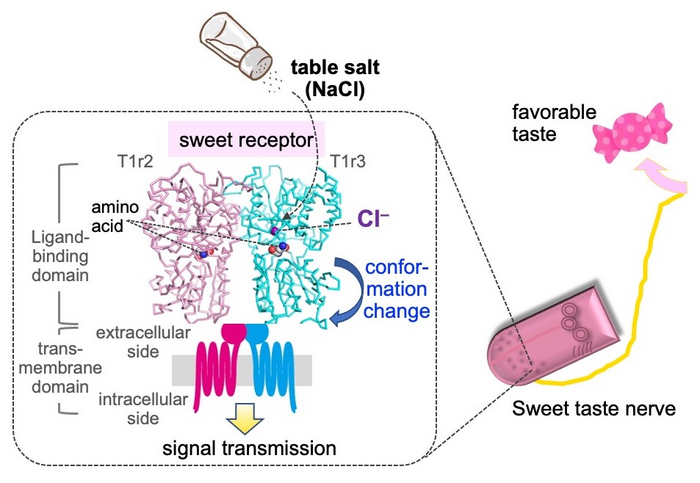Humans perceive five basic taste sensations: sweet, umami, bitter, salty, and sour. Specific foods trigger taste recognition of these sensations through the activation of different receptors in our taste buds. In the case for table salt, the concentration is also an important factor in determining taste. For instance, the preferable concentration of table salt is 100 mM, at which humans perceive a salty taste. However, higher concentrations of salt, over 500 mM, may be perceived as bitter and/or sour, while very low concentrations, below 10 mM, are perceived as sweet by humans. Scientific studies have proposed the presence of multiple salt detection pathways in the taste buds, but their exact mechanism is not fully understood.

Credit: Atsuko Yamashita from Okayama University
Humans perceive five basic taste sensations: sweet, umami, bitter, salty, and sour. Specific foods trigger taste recognition of these sensations through the activation of different receptors in our taste buds. In the case for table salt, the concentration is also an important factor in determining taste. For instance, the preferable concentration of table salt is 100 mM, at which humans perceive a salty taste. However, higher concentrations of salt, over 500 mM, may be perceived as bitter and/or sour, while very low concentrations, below 10 mM, are perceived as sweet by humans. Scientific studies have proposed the presence of multiple salt detection pathways in the taste buds, but their exact mechanism is not fully understood.
In the case of common salt (NaCl), salt taste sensation is primarily driven by the sodium ion, Na+. However, the anion (chloride ion Cl–) is also considered to be detected through unique molecular mechanisms and participate in the taste sensation. To investigate this chloride ion detection mechanism, scientists from Okayama University in Japan have conducted a study using structural biology methods and mice models. This study was published in eLife on 28th February, 2023.
The scientists had previously analyzed the structure of a taste receptor from the Japanese rice fish (medaka fish), which is similar to the human sweet taste receptor and is also compatible for structural analysis. A part of this fish taste receptor could bind to a chloride ion. Prof. Atsuko Yamashita explains, “We had previously analyzed the structure of the T1r2a/T1r3LBD receptor from medaka fish, which led us to the unexpected finding of the Cl– binding to T1r3LBD. In this study, we examined whether Cl– binding induces a conformational change of the receptor, and we were able to confirm the induction of this change by Cl–.” The conformational change (or change in structure) in the T1r receptors was found to be similar to that induced by other taste substances, suggesting that Cl– does activate the sweet receptors on T1r2a/ T1r3LBD. Since change in shape often indicates receptor activation, the scientists further explored the chloride ion activation of the sweet taste receptors (the T1r2/T1r3 heterodimers), which respond to sugars, in this study. Prof. Yamashita explains “We wanted to further investigate this phenomenon using better established animal models. Since the Cl–-binding site in T1r3 was conserved across various species, we decided to use taste nerve recordings from mice to explore the physiological significance of Cl–.”
To provide evidence for this, they performed electrophysiological assays on mice, where they could demonstrate the activation of neurons involved in signaling of sweet taste when small amounts of chloride were placed on the mice’s tongues. Thus, they demonstrated that low concentrations of Cl– could potentially produce a ‘light’ sweet taste sensation via the T1r in the taste buds. “The Cl–-induced taste is similar to that induced by canonical taste substances for T1rs, such as amino acids or sugars, though its efficacy is slightly lower.” says Prof. Yamashita. Further, when offered a choice between dilute chloride solution and plain water, the mice recognized the taste of chloride solution and demonstrated a preference for it. The concentration of sodium chloride for inducing a sweet response was found to be minute, even less than 10 mM, and this sweet sensation could be suppressed by the external application of sweet taste inhibitors containing gurmarin. These findings support the hypothesis that mice identify chloride as sweet via the action of specific receptors and neurons. They also show that dilute table salt provides a taste stimulus due to the presence of the Cl– ions.
Table salt is an important component in maintaining homeostasis or internal body equilibrium. This equilibrium is regulated by the optimum intake and excretion of sodium. This study shows that the former process uses the counter Cl– ion to regulate the molecular functions of the receptors involved. The results of this study will pave way for a more nuanced understanding of taste perception in organisms.
About Okayama University, Japan
As one of the leading universities in Japan, Okayama University aims to create and establish a new paradigm for the sustainable development of the world. Okayama University offers a wide range of academic fields, which become the basis of the integrated graduate schools. This not only allows us to conduct the most advanced and up-to-date research, but also provides an enriching educational experience.
Website: https://www.okayama-u.ac.jp/index_e.html
About Professor Atsuko Yamashita from Okayama University, Japan
Professor Atsuko Yamashita is associated with the Faculty of Medicine, Dentistry and Pharmaceutical Sciences at Okayama University in Japan. She has 64 publications related to the fields of protein structures, protein functions, and taste receptors. She has worked extensively towards research in the fields of life sciences.
Journal
eLife
DOI
10.7554/eLife.84291
Method of Research
Experimental study
Subject of Research
Animals
Article Title
Chloride ions evoke taste sensations by binding to the extracellular ligand binding domain of sweet/umami taste receptors
Article Publication Date
28-Feb-2023
COI Statement
No competing interests declared




